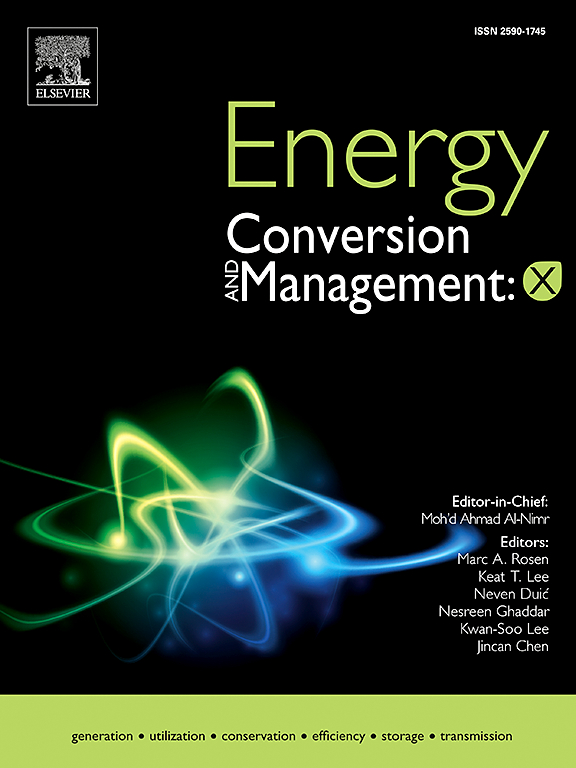Optimization and Shannon entropy multi-criteria decision-making method for implementing modern renewable energies in stand-alone greenhouses
IF 7.1
Q1 ENERGY & FUELS
引用次数: 0
Abstract
Commercial optimization tools often prioritize economic outcomes at the expense of sustainability and environmental performance. This limitation is particularly evident when evaluating renewable technologies with high capital costs, such as transparent agrivoltaic systems, compared to conventional photovoltaic alternatives. The lack of objective multi-criteria decision-making frameworks integrated with these tools presents a gap in supporting sustainable energy development, especially for policymakers. This study introduces a hybrid MATLAB/HOMER framework to optimize the energy supply of stand-alone greenhouse systems equipped with water treatment units in tropical climates. The framework integrates a Shannon Entropy-based TOPSIS method, implemented in MATLAB, to objectively rank system configurations using HOMER’s economic, technical, environmental, and energy security outputs. For an average daily load of about 100–110 kWh, the optimal configuration comprises 1.5 kW wind turbines, 4 kW transparent agrivoltaic panels, 14.5 kW conventional photovoltaic panels, a 10 kW diesel generator, 12 kWh of battery storage, and a 13.1 kW converter. This system achieves a levelized cost of electricity of $0.119 per kWh, a 51.2 % renewable energy share, and a lifetime CO2 reduction of 13,240 kg, while maintaining 100 % supply reliability. Additionally, the results show that the Shannon Entropy method provided a more decisive identification of the optimal scenario compared to the subjective Analytic Hierarchy Process (AHP). These findings demonstrate the effectiveness of entropy-weighted decision-making in identifying high-performance, sustainable energy solutions that extend beyond purely economic criteria, with zero unmet load.

独立大棚实施现代可再生能源的优化与Shannon熵多准则决策方法
商业优化工具往往以牺牲可持续性和环境绩效为代价,优先考虑经济结果。在评估具有高资本成本的可再生技术时,与传统的光伏替代方案相比,这种限制尤其明显,例如透明的农业光伏系统。缺乏与这些工具相结合的客观多标准决策框架,在支持可持续能源发展方面存在差距,特别是对决策者而言。本研究引入了一个混合MATLAB/HOMER框架来优化热带气候条件下配备水处理单元的独立温室系统的能源供应。该框架集成了基于香农熵的TOPSIS方法,在MATLAB中实现,使用HOMER的经济、技术、环境和能源安全输出客观地对系统配置进行排名。对于平均每日负荷约100-110千瓦时,最佳配置包括1.5千瓦的风力涡轮机,4千瓦的透明农业光伏板,14.5千瓦的传统光伏板,10千瓦的柴油发电机,12千瓦时的电池存储和13.1千瓦的转换器。该系统实现了每千瓦时0.119美元的电力成本,51.2%的可再生能源份额,在保持100%供应可靠性的同时,终生减少了13240公斤的二氧化碳。结果表明,与主观层次分析法(AHP)相比,香农熵法对最优情景的识别更具决定性。这些发现证明了熵加权决策在确定高性能、可持续的能源解决方案方面的有效性,这些解决方案超越了纯粹的经济标准,具有零未满足负荷。
本文章由计算机程序翻译,如有差异,请以英文原文为准。
求助全文
约1分钟内获得全文
求助全文
来源期刊

Energy Conversion and Management-X
Multiple-
CiteScore
8.80
自引率
3.20%
发文量
180
审稿时长
58 days
期刊介绍:
Energy Conversion and Management: X is the open access extension of the reputable journal Energy Conversion and Management, serving as a platform for interdisciplinary research on a wide array of critical energy subjects. The journal is dedicated to publishing original contributions and in-depth technical review articles that present groundbreaking research on topics spanning energy generation, utilization, conversion, storage, transmission, conservation, management, and sustainability.
The scope of Energy Conversion and Management: X encompasses various forms of energy, including mechanical, thermal, nuclear, chemical, electromagnetic, magnetic, and electric energy. It addresses all known energy resources, highlighting both conventional sources like fossil fuels and nuclear power, as well as renewable resources such as solar, biomass, hydro, wind, geothermal, and ocean energy.
 求助内容:
求助内容: 应助结果提醒方式:
应助结果提醒方式:


